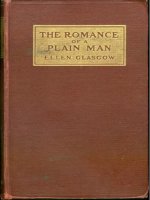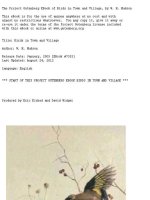The Project Gutenberg of On Laboratory Arts, by Richard Threlfall pot
Bạn đang xem bản rút gọn của tài liệu. Xem và tải ngay bản đầy đủ của tài liệu tại đây (4.28 MB, 892 trang )
The Project Gutenberg EBook of On
Laboratory Arts, by Richard Threlfall
This eBook is for the use of anyone
anywhere at no cost and with
almost no restrictions whatsoever. You may
copy it, give it away or
re-use it under the terms of the Project
Gutenberg License included
with this eBook or online at
www.gutenberg.org
Title: On Laboratory Arts
Author: Richard Threlfall
Release Date: September 27, 2007 [EBook
#22784]
Language: English
*** START OF THIS PROJECT GUTENBERG EBOOK
ON LABORATORY ARTS ***
Produced by Jon Richfield
ON
LABORATORY
ARTS
BY
RICHARD THRELFALL,
M.A.
PROFESSOR OF PHYSICS IN THE
UNIVERSITY OF SYDNEY;
MEMBER OF THE INSTITUTE OF
ELECTRICAL ENGINEERS;
ASSOCIATE-MEMBER OF THE
INSTITUTE OF CIVIL ENGINEERS;
MEMBER OF THE PHYSICAL
SOCIETY
London
MACMILLAN AND CO., LIMITED
NEW YORK: THE MACMILLAN COMPANY
1898
All rights reserved
PREFACE *
CHAPTER I *
HINTS ON THE MANIPULATION OF
GLASS AND ON GLASS-BLOWING FOR
LABORATORY PURPOSES *
§ 4. Soft Soda Glass, *
§ 6. Flint Glass. — *
§ 9. Hard or Bohemian, Glass. — *
§ 10. On the Choice of Sizes of Glass
Tube. — *
§ 11. Testing Glass. — *
§ 13. Cleaning Glass Tubes. — *
§ 14. The Blow-pipe. — *
§ 18. The Table. — *
§ 19. Special Operations. — *
§ 20. Closing and blowing out the End of a
Tube. — *
§ 21. To make a Weld. — *
§ 22. To weld two Tubes of different Sizes.
— *
§ 24. To weld Tubes of very small Bore. —
*
§ 30. To cut very thick Tubes. *
§ 31. To blow a Bulb at the End of a Tube.
— *
§ 32. To blow a bulb in the middle of a
tube, *
§ 33. To make a side Weld. — *
§ 34. Inserted Joints. — *
§ 35. Bending Tubes. — *
§ 36. Spiral Tubes. — *
§ 37. On Auxiliary Operations on Glass:- *
§ 38. Boring small Holes. — *
§ 39. For boring large holes through thick
glass sheets, *
§ 41. Operations depending on Grinding:
Ground-in Joints. — *
§ 42. Use of the Lathe in Glass-working. —
*
§ 46. Making Ground Glass. — *
§ 47. Glass-cutting. — *
§ 48. Cementing. — *
§ 49. Fusing Electrodes into Glass. — *
§ 51. The Art of making Air-tight Joints. —
*
APPENDIX TO CHAPTER I *
ON THE PREPARATION OF VACUUM
TUBES FOR THE PRODUCTION OF
PROFESSOR ROENTGEN'S RADIATION
*
CHAPTER II *
GLASS-GRINDING AND OPTICIANS'
WORK *
§ 61. Details of the Process of Fine
Grinding. — *
§ 62. Polishing. — *
§ 63. Centering. — *
§ 65. Preparing Small Mirrors for
Galvanometers. — *
§ 66. Preparation of Large Mirrors or
Lenses for Telescopes. — *
§ 69. The Preparation of Flat Surfaces of
Rock Salt. — *
§ 70. Casting Specula for Mirrors. — *
§ 71. Grinding and polishing Specula. — *
§ 72. Preparation of Flat Surfaces. — *
§ 73. Polishing Flat Surfaces on Glass or
on Speculum Metal. — *
CHAPTER III *
MISCELLANEOUS PROCESSES *
§ 74. Coating Glass with Aluminium and
Soldering Aluminium. — *
§ 75. The Use of the Diamond-cutting
Wheel. — *
§ 76. Arming a Wheel. — *
§ 77. Cutting a Section. — *
§ 78. Grinding Rock Sections, or Thin Slips
of any Hard Material.— *
§ 79. Cutting Sections of Soft Substances.
— *
§ 80. On the Production of Quartz Threads.'
— *
§ 84. Drawing Quartz Threads. — *
§ 86. Drawing Threads by the Catapult. — *
§ 87. Drawing Threads by the Flame alone.
— *
§ 88. Properties of Threads. — *
§ 90. On the Attachment of Quartz Fibres.
— *
§ 91. Other Modes of soldering Quartz. —
*
§ 92. Soldering. — *
§ 94. Preparing a Soldering Bit. — *
§ 95. Soft Soldering. — *
§ 97. Soldering Zinc. — *
§ 98. Soldering other Metals — *
§ 99. Brazing. *
§ 100. Silver Soldering. — *
§ 101. On the Construction of Electrical
Apparatus - Insulators. — *
§ 102. Sulphur. — *
§ 103. Fused Quartz. — *
§ 104. Glass. — *
§ 105. Ebonite or Hard Rubber. — *
§ 106. Mica. — *
§ 107. Use of Mica in Condensers. — *
§ 108. Micanite. — *
§ 109. Celluloid. — *
§ 110. Paper. *
§ 111. Paraffined Paper. — *
§ 112. Paraffin — *
§ 113. Vaseline, Vaseline Oil, and
Kerosene Oil. — *
§ 114. Imperfect Conductors. — *
§ 116. Conductors. — *
§ 117. Platinoid. — *
§ 119. Platinum Silver. — *
§ 120. Platinum Iridium. — *
§ 121. Manganin. — *
§ 122. Other Alloys. — *
§ 123. Nickelin. — *
§ 124. Patent Nickel. — *
§ 125. Constantin. — *
126. Nickel Manganese Copper. — *
CHAPTER IV *
ELECTROPLATING AND ALLIED ARTS
*
§ 127. Electroplating. — *
§ 128. The Dipping Bath. — *
§ 130. Scratch-brushing. — *
§ 131. Burnishing. — *
§ 132. Silver-plating. — *
§ 133. Cold Silvering. — *
§ 134. Gilding. — *
§ 135. Preparing Surfaces for Gilding. — *
§ 136. Gilding Solutions. — *
§ 137. Plating with Copper. — *
§ 138. Coppering Aluminium. — *
§ 140. Alkaline Coppering Solution — *
§ 141. Nickel-plating.— *
142. Miscellaneous Notes on
Electroplating. *
§ 143. Blacking Brass Surfaces. — *
§ 144. Sieves. — *
§ 145. Pottery making in the Laboratory.
— *
APPENDIX *
PLATINISING GLASS *
PREFACE
EXPERIMENTAL work in physical
science rests ultimately upon the
mechanical arts. It is true that in a
well-appointed laboratory, where
apparatus is collected together in
greater or less profusion, the appeal
is often very indirect, and to a
student carrying out a set experiment
with apparatus provided to his hand,
the temptation to ignore the
mechanical basis of his work is often
irresistible.
It often happens that young physicists are
to be found whose mathematical
attainments are adequate, whose
observational powers are perfectly
trained, and whose general capacity is
unquestioned, but who are quite unable to
design or construct the simplest apparatus
with due regard to the facility with which
it ought to be constructed. That ultimate
knowledge of materials and of processes
which by long experience becomes
intuitive in the mind of a great inventor of
course cannot be acquired from books or
from any set course of instruction.
There are, however, many steps between
absolute ignorance and consummate
knowledge of the mechanical arts, and it is
the object of the following pages to assist
the young physicist in making his first
steps towards acquiring a working
knowledge of "laboratory arts." However
humble the ambition may be, no one can
be more keenly alive than the writer to the
inadequacy of his attempt; and it is only
from a profound sense of the necessity
which exists for some beginning to be
made, that he has had the courage to air
his views on matters about which there
are probably hundreds or thousands of
people whose knowledge is superior to
his own.
Moreover, nothing has been further from
the writer's mind than any idea of
"instructing" any one; his desire is — if
happily it may so befall — to be of
assistance, especially to young physicists
or inventors who wish to attain definite
mechanical ends with the minimum
expenditure of time. Most people will
agree that one condition essential to
success in such an undertaking is brevity,
and it is for this reason that alternative
methods as a rule have not been given,
which, of course, deprives the book of any
pretence to being a "treatise." The writer,
therefore, is responsible for exercising a
certain amount of discretion in the
selection he has made, and it is hardly to
be hoped that he has in all — or even in
the majority of cases — succeeded in
recommending absolutely the best method
of procedure.
This brings another point into view.
Before all things the means indicated must
be definite and reliable. It is for this
reason that the writer has practically
confined himself to matters lying within
his own immediate experience, and has
never recommended any process (with
one or two minor exceptions, which he
has noted) which he has not actually and
personally carried through to a successful
issue. This, although it is a matter which
he considers of the highest importance,
and which is his only title to a hearing, has
unfortunately led to a very personal tone
in the book.
With regard to the arts treated of in the
following pages, matters about which
information is easily acquired — such as
carpentering, blacksmithing, turning, and
the arts of the watchmaker — have been
left on one side. With regard to the last,
which is of immense use in the laboratory,
there happen to be at least two excellent
and handy books, viz. Saunier's
Watchmakers' Handbook, Tripplin,
London, 1892; and Britton's Watchmakers'
Dictionary and Guide.
With regard to carpentering, turning, and
blacksmithing, almost any one who so
desires can obtain a little practical
experience in any village. A short chapter
has been devoted to GLASS-BLOWING,
in spite of there being an excellent and
handy book by Mr. Shenstone (The
Methods of GLASS-BLOWING,
Rivington) on the subject already in
existence. The reason for this exception
lies in the fact that the writer's methods
differ considerably from those advocated
by Mr. Shenstone.
The chapter on opticians' work has had to
be compressed to an extent which is
undesirable in dealing with so complex
and delicate an art, but it is hoped that it
will prove a sufficient introduction for
laboratory purposes. In this matter the
writer is under great obligations to his
friend and assistant, Mr. James Cook,
F.R.A.S., who gave him his first lessons
in lens-making some twenty years ago. To
Mr. John A. Brashear of Allegheny, Pa.,
thanks are due for much miscellaneous
information on optical work, which is
included verbatim in the text, some of it
contained originally in printed papers, and
some most kindly communicated to the
writer for the purpose of this book. In
particular, the writer would thank Mr.
Brashear for his generously accorded
information as to the production of those
"flat" surfaces for which he is so justly
famous.
The writer is also indebted to Mr. A. E.
Kennelly for some information as to
American practice in the use of insulating
material for electrical work, and to his
friends Mr. J. A. Pollock and Dr. C. J.
Martin for many valuable suggestions. For
the illustrations thanks are due to Mrs.
Threlfall and Mr. James Cook. With
regard to matters which have come to the
writer's knowledge by his being
specifically instructed in them from time
to time, due acknowledgment is, it is
hoped, made in the text.
With regard to the question as to what
matters might be included and what
omitted, the general rule has been to
include information which the author has
obtained with difficulty, and to leave on









